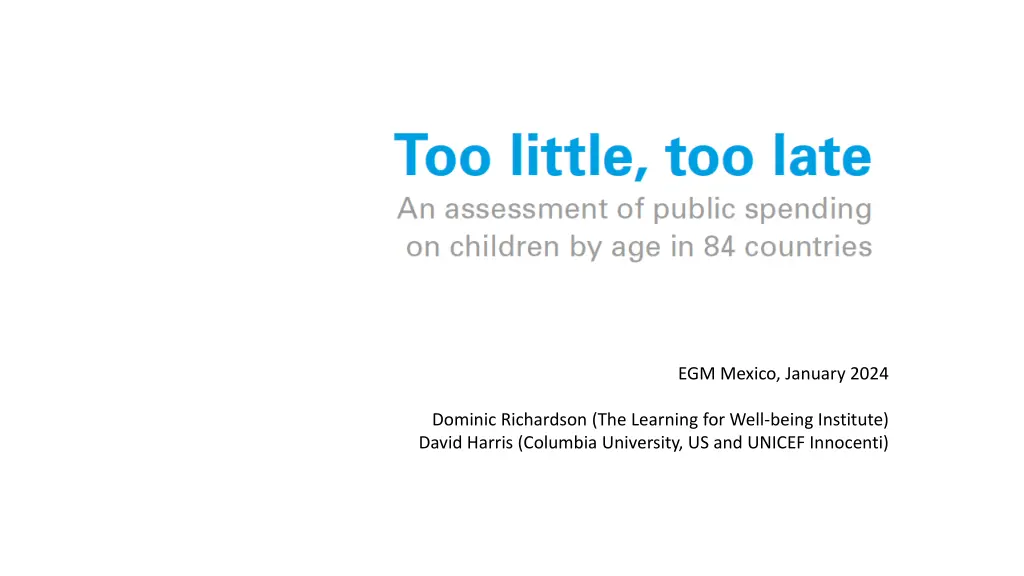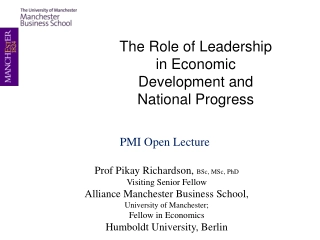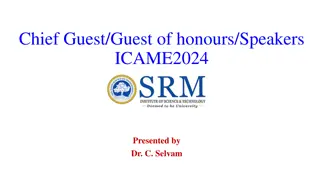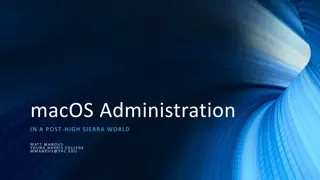
Understanding Investment in Children: Key Messages and Expenditure Figures
Explore the challenges in managing child and family policies globally, uncover the underinvestment in children, and learn about crucial skills for child development. Discover insights on early childhood development, diverse investments, and achieving SDGs amidst inequalities.
Uploaded on | 1 Views
Download Presentation

Please find below an Image/Link to download the presentation.
The content on the website is provided AS IS for your information and personal use only. It may not be sold, licensed, or shared on other websites without obtaining consent from the author. If you encounter any issues during the download, it is possible that the publisher has removed the file from their server.
You are allowed to download the files provided on this website for personal or commercial use, subject to the condition that they are used lawfully. All files are the property of their respective owners.
The content on the website is provided AS IS for your information and personal use only. It may not be sold, licensed, or shared on other websites without obtaining consent from the author.
E N D
Presentation Transcript
EGM Mexico, January 2024 Dominic Richardson (The Learning for Well-being Institute) David Harris (Columbia University, US and UNICEF Innocenti)
Key Messages There is no consensus on how to manage a portfolio of child and family policies worldwide; best evidence is not followed; data on how and when expenditure happens is incomplete Available data shows chronic underinvestment in children, particularly in the early year, and a relative underinvestment in both cash and care services in non-OECD countries In the poorest countries, children that miss out on school receive less 3 thousand USD PPP per head throughout childhood and under 6 s receive less than 7 per cent of total OECD countries spending shows a slight trend increase in family policy spending overall, with larger relative increases in early years spending and childcare specifically The poly-crisis risks both domestic spending and foreign assistance 5/3/2025 2
Understanding the when & how of investment in children Consensus on importance of early childhood dev. across sectors Critical for inclusive development Within and between country inequalities Demand for greater effectiveness and efficiency Achievement of the SDGs 5/3/2025 3
Age-related development of elementary skills Listening, Empathising, Inquiring Discerning patterns, Embodying, Observing, Reflecting, Relaxing, Sensing Fluency in: ideation, divergent thinking, self-regulation (ado), affective empathy, intuition Source: Richardson et al, 2021 5/3/2025 4
Understanding the when & how of investment in children Consensus on importance of early childhood dev. across sectors Critical for inclusive development Within and between country inequalities Demand for greater effectiveness and efficiency Achievement of the SDGs 5/3/2025 5
Key expenditure figures Low-income countries spend just USD 11 thousand PPP per child if they attend preschool and complete compulsory school, and just 2.3 thousand per child capita overall. Just 6.7 percent of this is reserved for the under sixes. Low-middle income countries are spending USD 18 thousand per child if they attend preschool and complete compulsory school, and 13.6 thousand per child capita overall. Just 8.2 percent of this is reserved for the under sixes. Upper-middle income countries are spending USD 43 thousand per child when attending both school and pre-school, and 35.3 thousand per child overall. Just 11.5 percent of this is reserved for the under sixes. High-income countries are spending USD 195 thousand per child when attending both school and pre-school. And 27 percent of this is reserved for the under sixes. 5/3/2025 6
Comparing age-related expenditure profiles ASPIRE expenditures SSPTW Manchester University, Social Assistance Explorer UIS education statistics (expenditures and enrolment) OECD sources Only public spending Local spending underestimated Health spending is missing, but marginal Does not measure service quality Take-up Averages hide detail by child need Relies on a few assumptions UN Population data World Bank DataBank GDP, NCUs, and USD/PPPs OECD has better data! 5/3/2025 7
Understanding the Age-Spending Profiles 5/3/2025 8
Balance of cross Balance of cross- -sectoral spending in sectoral spending in LMIC countries LMIC countries 5/3/2025 9
Differences in expenditures on young Differences in expenditures on young children in LMIC countries children in LMIC countries 5/3/2025 10
Differences in family policy expenditures Differences in family policy expenditures in OECD countries in OECD countries Source: OECD, 2023 5/3/2025 11
Examples of country profiles Per capita child spend (USD PPP) Adapted from: Heckman (2007) Source: Richardson et al, 2023 Age of the child 5/3/2025 13 Source: Richardson et al, 2023
How & when money is spent on children matters!
Comparing national income Comparing national income groups differences groups differences 5/3/2025 15 Source: Richardson et al, 2023
Delivering on a Universal Child Benefit Delivering on a Universal Child Benefit Only one in every four children aged 0 18 years have access to a child or family benefit Global crises have demonstrated how essential social protection systems are for achieving the rights of children Significant underinvestment in social protection has contributed to persistent gaps in coverage for children. Evidence shows UCBs to be a cost-effective way to reduce child poverty in both absolute and relative terms Currently, 46 countries and territories operate UCBs or quasi-UCBs. The details matter. Policy design should be informed by international social security standards
Trend changes in OECD spending on under-6 s pre-Covid 18 Source: OECD, 2023
Priority recommendations Priority recommendations Provide more for all of the youngest children, and families with the youngest children Prioritize social protection policies that are inclusive of all children, beginning with UCBs as the foundational policy for children Use foreign assistance, and other less-sustainable sources of finance, to catalyse efforts to strengthen welfare systems Undertake incremental adjustment to the child policy portfolio Utilize international goals and agreements in efforts to promote political will and consensus for change, particularly for the youngest children






















